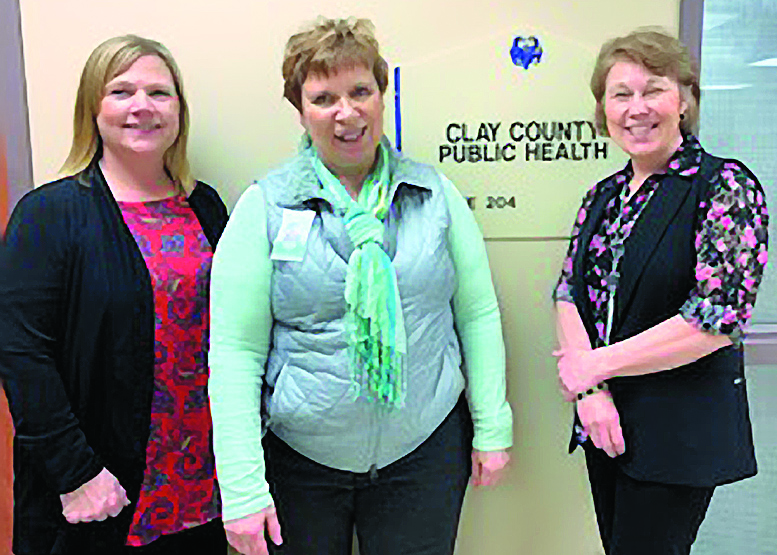
Nancy Edmonds Hanson
nancy.edmonds.hanson@gmail.com
The disease prevention experts of the Clay County Health Department have been preparing for this moment for years – one Health Officer Kathy McKay says they have expected, but hoped would never come.
“COVID-19 is definitely in our community,” says the registered nurse, who heads the county unit of nearly 100 employees. That certainty is based, she explains, on a change that was documented in Minnesota March 15, when the first confirmed case was tied to community-spread contagion: “This is now not just about overseas travel or having had contact with a traveler. It’s being transferred from person to person.” Her suspicion was confirmed Tuesday when Cass County reported its first confirmed case.
The community has grappled with epidemics before, from yearly onslaughts of influenza to the H1N1 virus known as swine flu that ravaged the nation in 2009. But this one, she says, is different. Health care could fight that outbreak with antiviral medications and ultimately vaccine.
The novel coronavirus presents a different kind of challenge. “Novel” – it’s entirely new in humans and unfamiliar to their immune system, leaving victims defenseless. Researchers around the world have been working frantically to decode its RNA and discover its secrets, keys to both identifying the infection and develop drugs to combat it. In the meantime, though, human transmission has been relentless, while the virus itself has not stood still, buttressing its own power to skip from victim to victim.
Part of McKay’s certainty that the disease already walks among us is based on the lack of testing. With tests hard to come by and (until lately) limited to those with obvious risk factors like overseas travel, the extent of the infection is utterly unknown. Many – perhaps most – who are infected develop only mild symptoms that may even be overlooked. But no matter how active or ill, they can easily spread the highly contagious virus. “You can be asymptomatic, at least at first, but still be a carrier,” she explains. “Those under 19 are not considered to be at high risk, but they can spread it.”
Men and women over 70 and others with conditions that put them at risk like heart disease, asthma and diabetes, she says, are the most likely to become severely ill. But that doesn’t mean COVID-19’s devastation is limited to people who fit that profile. Some victims in Minnesota and elsewhere have been in their 40s, 50s and 60s, or even younger; the first confirmed case was a 20-year-old.
On Tuesday, McKay and members of her incident command team – nursing director Jamie Hennen, disease prevention coordinator Cheryl Sapp and emergency preparedness manager Joshua Ebert – updated the Clay County Commission with the latest guidance from the Minnesota Department of Health and the Centers for Disease Control. “We’re lucky in Minnesota to have a close partnership with the Department of Health,” she told commissioners. “We support each other at times like this.”
That partnership continues to generate a rolling tide of updates and information. As the evolving situation led to the governor’s school cancellation last week and closure of restaurants, bars, health clubs and other facilities Monday, the Clay department has passed the information on to its partners in long-term care, social services, and the area health-care community. Guidance has changed: Advice to avoid gatherings of more than 250 was reduced to 50 and, this week, to groups of 10 or fewer. The threshold of highest risk was raised from 60 to 70. Other benchmarks, too have evolved.
For residents, the most helpful advice has held steady. “Stay informed,” she urges. Social distancing is a basic – stay at least six feet from others, don’t shake hands, and of course scrub those fingers after being in public and touching surfaces whose germ status is suspect.
“Find new ways to communicate,” the team suggested. “Talk on the phone. Use Facetime to visit with Grandma and Grandpa.” It’s important to socialize, but do it at a distance. Speaking of distances, they said, it’s a good idea to also limit discretionary travel and trade commuting for working at home.
And then there’s the big one – the one that has emptied the stores and streets of many cities, but seems yet to have great impact on Moorhead. “Stay home!” McKay told the commissioners. That’s becoming easier as virtually every church service, sporting event, performance and social gathering has been taken off the calendar, to be postponed, migrated to online video or canceled outright. Routine appointments and elective surgery can be booked for a later date.
At the same time, McKay says, the guidelines doesn’t mean that everyone must hole up at home. “We don’t want to say, ‘Stop everything.’ That’s good advice for those at the highest risk, yet probably not necessary for everybody at this time.” (She adds, “That may change. Stay tuned.”)
Most who contract the novel coronavirus will recover at home, freeing up hospital beds and personnel for those who are sickest. Symptoms to watch for include a dry cough, fever and difficulty breathing, though muscle and headaches may also occur. More information on identifying the new virus versus influenza and other respiratory illness is available on the Department of Health website, https://www.health.state.mn.us/diseases/coronavirus/index.html
As of Tuesday, Clay County’s health officer had not been notified of any confirmed COVID-19 cases in Clay County nor in neighboring Becker, Wilkin and Otterrail. “But we know it’s coming,” she emphasizes. “It’s imperative that everyone is diligent so we can slow and limit its spread.”


